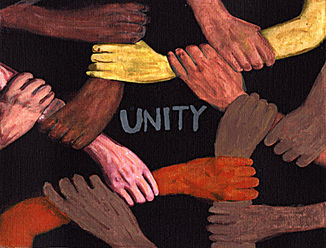 When Jesus’ bride is divided racially, socio-economically, and culturally we are a fragmented bride. This is not God’s plan for his Church. Abundant accounts are given throughout Scripture of God unifying the diverse for His name to be made known in the earth. Revelation describes the great multitude gathered around the throne of God from every nation, tribe, people and language (Rev. 7:9). This is our model for Church Like Heaven. “The global church [celebrating] astonishing cultural diversity while enjoying unity in Christ” is our example for helping advance the Kingdom of God today (Shenk, 402). Jesus prays for us in John 17 that we, his disciples, would be one just as Christ, the Father and Spirit are one, in order that the world would believe (John 17:20-23). Not only will this be a testament to the world of the saving love of the triune God, but it also brings about the kingdom of God via the human soul, not through revolution (Montgomery, 64). The hope for a united Church is profound, but the path to completion is a strenuous one. With Christ’s work on the cross breaking down the ultimate barrier between humankind and God there is potential and promise for the wall of hostility to be broken down between people groups. The Church of Jesus Christ in America could not be in a more opportune time to lead in and pour out the reconciling love of God. We can see God tearing down the dividing wall of hostility in our city by displaying his grace in our lives through cross-racially healed relationships and also addressing historic and systemic injustices. Our greatest obstacle is the absence of authentic relationships spanning racial and socio-economic opposites. A subsequent fruit of diverse unity within missio Dei is multi-cultural teams going into all the earth. According to Harvie Conn, “indigenization validates all human languages and cultures before God as legitimate paths for understanding his divine meanings” (481). God’s image is represented in every human being, from every unique culture. When groups of people penetrate a new culture while bringing multiple cultures with them, they create openness in the recipients simply by being diverse. Each unique missionary reflects the image of God encouraging those hearing the good news that God’s image is also in them and that His gospel includes them. Although we know the consummation of missio Dei to be the New Jerusalem, we will continue the work of being missionaries, even as Paul, in explaining the mystery of the gospel to the world. Our hope is that as the homeless, CEOs, brown, white, male, female, Hindu, atheist, urban, suburban, walk through the doors of our church, they will feel safe enough to stay and hear the beautiful, matchless story of the unified triune God providing a way of salvation through the cross. Conn, Harvie M. 2000. “Indigenization.” In Evangelical Dictionary of World Missions, general editor A. Scott Moreau; associate editors, Harold Netland and Charles Van Engen; consulting editors David Burnett, et al., 481-482. Grand Rapids: Baker. Montgomery, Helen Barrett with Shawn B. Redford. ed. 2000. The Bible and Missions. Revised Edition. Pasadena, CA: Fuller Theological Seminary. Shenk, David W. 2000. “The Gospel and Culture.” In Evangelical Dictionary of World Missions, general editor A. Scott Moreau; associate editors, Harold Netland and Charles Van Engen; consulting editors David Burnett, et al., 401-402. Grand Rapids: Baker. If you enjoyed this post check out Belkis Lehmann's recent post, Unity. 11/5/2021 03:23:42 am
Very much appreciated. Thank you for this excellent article. Keep posting! Comments are closed.
|
Categories
All
Contributing Authors
|

 RSS Feed
RSS Feed